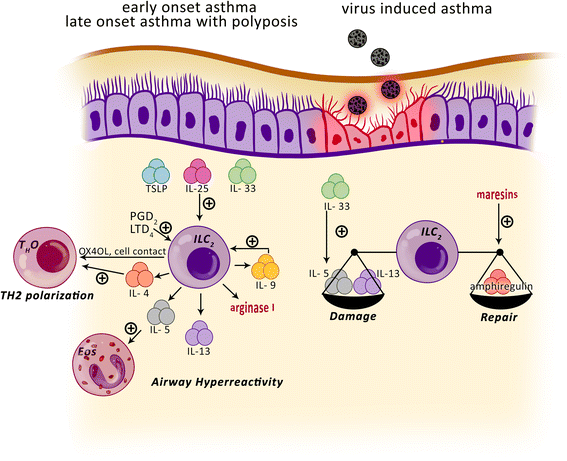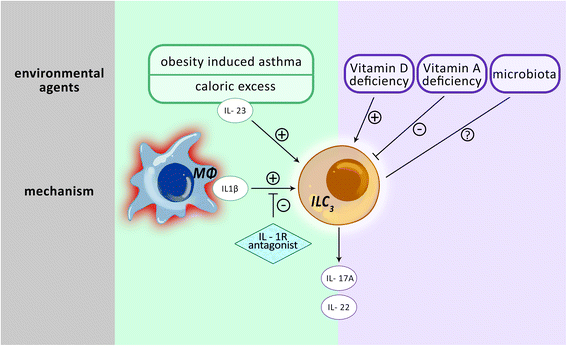Innate lymphocyte cells in asthma phenotypes
- PMID: 26150907
- PMCID: PMC4491887
- DOI: 10.1186/s13601-015-0068-5
Innate lymphocyte cells in asthma phenotypes
Erratum in
-
Erratum to: Innate lymphoid cells in asthma phenotypes.Clin Transl Allergy. 2015 Sep 15;5:32. doi: 10.1186/s13601-015-0075-6. eCollection 2015. Clin Transl Allergy. 2015. PMID: 26380068 Free PMC article.
Abstract
T helper type 2 (TH2) cells were previously thought to be the main initiating effector cell type in asthma; however, exaggerated TH2 cell activities alone were insufficient to explain all aspects of asthma. Asthma is a heterogeneous syndrome comprising different phenotypes that are characterized by their different clinical features, treatment responses, and inflammation patterns. The most-studied subgroups of asthma include TH2-associated early-onset allergic asthma, late-onset persistent eosinophilic asthma, virus-induced asthma, obesity-related asthma, and neutrophilic asthma. The recent discovery of human innate lymphoid cells capable of rapidly producing large amounts of cytokines upon activation and the mouse data pointing to an essential role for these cells in asthma models have emphasized the important role of the innate immune system in asthma and have provided a new means of better understanding asthma mechanisms and differentiating its phenotypes.
Keywords: Airways; Asthma; Cytokines; Innate immunity; Phenotype.
Figures


Similar articles
-
Type 2 innate lymphoid cells: at the cross-roads in allergic asthma.Semin Immunopathol. 2016 Jul;38(4):483-96. doi: 10.1007/s00281-016-0556-2. Epub 2016 Mar 10. Semin Immunopathol. 2016. PMID: 26965110 Free PMC article. Review.
-
Immunologic mechanisms in asthma.Semin Immunol. 2019 Dec;46:101333. doi: 10.1016/j.smim.2019.101333. Epub 2019 Nov 6. Semin Immunol. 2019. PMID: 31703832 Review.
-
T cells are necessary for ILC2 activation in house dust mite-induced allergic airway inflammation in mice.Eur J Immunol. 2016 Jun;46(6):1392-403. doi: 10.1002/eji.201546119. Epub 2016 May 12. Eur J Immunol. 2016. PMID: 27062360
-
Cellular mechanisms underlying eosinophilic and neutrophilic airway inflammation in asthma.Mediators Inflamm. 2015;2015:879783. doi: 10.1155/2015/879783. Epub 2015 Mar 23. Mediators Inflamm. 2015. PMID: 25878402 Free PMC article. Review.
-
Inhibition of Bruton's tyrosine kinase and IL-2 inducible T-cell kinase suppresses both neutrophilic and eosinophilic airway inflammation in a cockroach allergen extract-induced mixed granulocytic mouse model of asthma using preventative and therapeutic strategy.Pharmacol Res. 2019 Oct;148:104441. doi: 10.1016/j.phrs.2019.104441. Epub 2019 Sep 7. Pharmacol Res. 2019. PMID: 31505252
Cited by
-
Immunologic Basis of Type 2 Biologics for Severe Asthma.Immune Netw. 2022 Dec 5;22(6):e45. doi: 10.4110/in.2022.22.e45. eCollection 2022 Dec. Immune Netw. 2022. PMID: 36627938 Free PMC article. Review.
-
A mutually beneficial collaboration between the European Academy of Allergy and Clinical Immunology Junior Members and Clinical and Translational Allergy.Clin Transl Allergy. 2016 Dec 1;6:43. doi: 10.1186/s13601-016-0133-8. eCollection 2016. Clin Transl Allergy. 2016. PMID: 27957322 Free PMC article.
-
Extracellular Vesicles in Asthma: Intercellular Cross-Talk in TH2 Inflammation.Cells. 2025 Apr 3;14(7):542. doi: 10.3390/cells14070542. Cells. 2025. PMID: 40214495 Free PMC article. Review.
-
Airway innate lymphoid cells in the induction and regulation of allergy.Allergol Int. 2019 Jan;68(1):9-16. doi: 10.1016/j.alit.2018.11.001. Epub 2018 Nov 23. Allergol Int. 2019. PMID: 30473412 Free PMC article. Review.
-
Asthma Phenotypes in the Era of Personalized Medicine.J Clin Med. 2023 Sep 26;12(19):6207. doi: 10.3390/jcm12196207. J Clin Med. 2023. PMID: 37834850 Free PMC article. Review.
References
-
- Annunziato F, Romagnani C, Romagnani S. The 3 major types of innate and adaptive cell-mediated effector immunity. J Allergy and Clinical Immunology. 2014. doi:10.1016/j.jaci.2014.11.001 - PubMed
Publication types
LinkOut - more resources
Full Text Sources
Other Literature Sources

